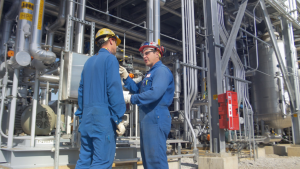Recap and Recording: Industrial Energy Efficiency
Industrial efficiency was the focus of VAEEC’s third webinar in our quarterly series. “Opportunities for Industrial Energy Efficiency in the Commonwealth” provided an opportunity for participants to learn about Combined Heat and Power (CHP) and Waste Heat to Power (WHP) and how it can make Virginia manufacturers more competitive, save money for all ratepayers, and lower the state’s emissions.
Thank you to the webinar sponsor, the Alliance for Industrial Efficiency. 
Download the presentation and recording.
We were honored to have three knowledgeable speakers who were able to share their expertise with attendees:
- Jennifer Kefer, Alliance for Industrial Efficiency
- Dalia El Tawy, Siemens
- Charles Miller, WGL Energy
Over the course of an hour, they were able to provide an overview of CHP/WHP (including their importance, benefits, and scale of opportunity), examples of CHP/WHP being used across the globe, programs and barriers in Virginia, and what more needs to happen to get CHP/WHP in the state.
 There are currently 4,400 CHP projects installed nationwide, and the majority are used for industrial applications. Manufacturer, public, and utility benefits of CHP include increased productivity and decreased operating costs. Hood Dairy in Winchester, Virginia, provides a good example. Hood worked with ZF Energy Development to design a 15-MW microgrid, which includes CHP. Not only does this give Hood a reliable, efficient source of power and food security, but it has allowed them to achieve a net savings of at least 25% when compared to grid power and 30% reduced emissions.
There are currently 4,400 CHP projects installed nationwide, and the majority are used for industrial applications. Manufacturer, public, and utility benefits of CHP include increased productivity and decreased operating costs. Hood Dairy in Winchester, Virginia, provides a good example. Hood worked with ZF Energy Development to design a 15-MW microgrid, which includes CHP. Not only does this give Hood a reliable, efficient source of power and food security, but it has allowed them to achieve a net savings of at least 25% when compared to grid power and 30% reduced emissions.
Unfortunately, a gap exists between Virginia’s CHP technical potential and its deployment. With 4,308 MW of potential projects, over two times our current capacity, the Department of Energy found Virginia to have the eleventh highest technical potential for implementation in the country. Investments in CHP and industrial efficiency could lead to a slew of benefits for Virginia, including saving 6.6 million megawatt-hours of electricity by 2030 and saving Virginia businesses $4.1 billion between 2016-2030 in avoided electricity costs.
One of the main barriers for states in the Southeast are highly competitive electricity prices due to the prevalence of coal and nuclear. To increase the use of CHP and WHP in the Commonwealth, we need more state incentives for CHP deployment. Moreover, implementing state policies aimed towards acquiring energy savings from CHP would encourage additional CHP installations. Creating interconnection standards with regard to technologies and fuels could also enhance standards and support CHP deployment within Virginia.
This webinar provided a good background on what CHP and WHP are and how they work, their benefits, the scale of opportunity in Virginia, and what needs to be done to get more CHP/WHP in the state. If you were unable to attend this webinar, you can watch the webinar recording or download the presentation here.
